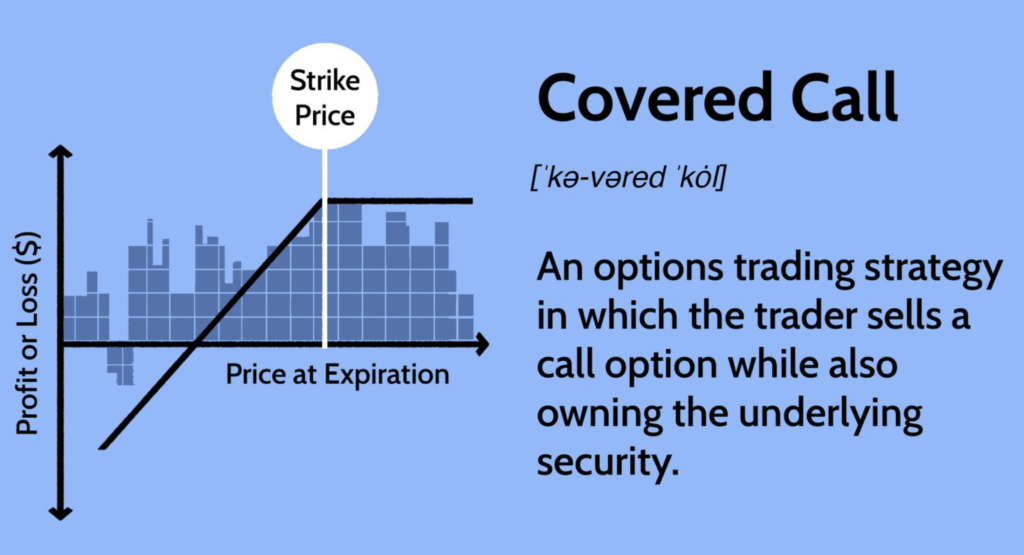Are you an investor looking for a way to generate additional income from your stock portfolio? Consider the covered call strategy, a popular options trading strategy that can help you earn extra money while potentially reducing risk. The covered call strategy involves selling call options on stocks that you already own. What’s a covered call strategy?
When you sell a call option, you are giving someone else the right to buy your stock at a specific price (the strike price)on or before a specific date (the expiration date). In exchange for this right, the buyer of the call option pays you a premium.
If the stock price stays the same or goes down, you keep the premium you received for selling the call option. If the stock price goes up and the call option is exercised, you sell your stock at the strike price, which may be higher than the current market price. Either way, you keep the premium you received for selling the call option.
The covered call strategy can be a way to generate additional income from your stock portfolio, especially in a flat or slightly bullish market. It can also help reduce risk by providing a cushion against potential losses if the stock price goes down.
However, there are some potential drawbacks to the covered call strategy. If the stock price rises significantly, you may miss out on potential gains because you have already agreed to sell your stock at the strike price. Additionally, if the stock price falls sharply, the premium you received for selling the call option may not be enough to offset your losses.
In our upcoming blog article, we will dive deeper into the covered call strategy, discussing its potential benefits and drawbacks, as well as how to implement it effectively. Stay tuned to learn more about this popular options trading strategy.
What’s a Covered Call Strategy?
Let’s say that a trader owns 100 shares of Microsoft (MSFT), which is currently trading at $260 per share. The trader believes that the stock price will stay relatively stable over the next few weeks but wants to generate some extra income from their position.
The trader decides to sell a call option with a strike price of $270 and an expiration date of one month from now. The trader receives a premium of $5 per share for selling the call option, which amounts to a total of $500 (100 shares x $5 per share).
If the stock price stays below $270 until the expiration date, the call option will expire worthless and the trader keeps the $500 premium. If the stock price goes above $270 and the call option is exercised, the trader will have to sell their 100 shares of Microsoft for $270 per share, which is higher than the current market price of $260 per share. The trader still gets to keep the $500 premium they received for selling the call option, but misses out on any potential gains above $270 per share.
Overall, the covered call strategy can be an effective way for traders to generate additional income from their stock positions while potentially reducing risk. However, it’s important to keep in mind that there are potential drawbacks and risks associated with this strategy, including missed potential gains and limited downside protection.

Before implementing this strategy on any particular stock, traders should carefully consider the potential benefits and drawbacks and ensure that it aligns with their overall investment goals and risk tolerance.
How Does it Compare to Other Strategies?
When it comes to options trading strategies, there are many different approaches that traders can take. The covered call strategy is just one of several options trading strategies available. Let’s take a look at how the covered call strategy compares to some other popular options trading strategies:
| Strategy | Description | Pros | Cons |
|---|---|---|---|
| Covered Call Strategy | Sell call options on a stock that you already own. If the stock price stays the same or goes down, you keep the premium you received for selling the call option. If the stock price goes up and the call option is exercised, you sell your stock at the strike price, which may be higher than the current market price. Either way, you keep the premium you received for selling the call option. | Generates additional income from a stock position; can potentially reduce risk; relatively simple to execute. | Misses out on potential gains if the stock price rises significantly; limited downside protection if the stock price falls sharply. |
| Long Call Strategy | Buy call options on a stock that you believe will increase in price. If the stock price rises, you can exercise the call option and buy the stock at the lower strike price, then sell it at the higher market price. If the stock price doesn’t rise, you can let the call option expire and only lose the premium you paid for the option. | Potential for significant gains if the stock price rises; limited downside risk since you can only lose the premium paid for the call option. | If the stock price doesn’t rise, the entire premium paid for the call option is lost; requires accurate timing and prediction of the stock price movement. |
| Iron Condor Strategy | Sell both a call option and a put option on a stock at different strike prices, while also buying a call option and a put option at even further strike prices. This creates a “condor” shape on a graph of potential profits and losses. The goal is to profit from the premiums received from selling the options, while also limiting potential losses with the purchased options. | Offers potential for profit even if the stock price remains stable; limited risk since potential losses are capped. | Requires precise execution of multiple trades; can be difficult to manage if the stock price moves too much. |
| Straddle Strategy | Buy both a call option and a put option on a stock at the same strike price and expiration date. This is typically done when the trader expects the stock price to make a significant move in either direction. If the stock price moves up, the call option can be exercised for profit, and if the stock price moves down, the put option can be exercised for profit. | Can profit from a significant move in either direction; limited risk since potential losses are capped. | Requires accurate prediction of the stock price movement; the premiums for both the call and put options must be paid, increasing the overall cost of the trade. |
Conclusion
In conclusion, options trading strategies offer traders a wide range of approaches to take when trying to profit from the markets. Each strategy has its own set of pros and cons, and it’s important for traders to carefully consider their goals and risk tolerance when choosing a strategy.
The covered call strategy is a popular options trading strategy for generating additional income from a stock position while potentially reducing risk. It’s relatively simple to execute and can be an effective way to enhance returns in a sideways or slightly bullish market. However, it may not be the best strategy for traders looking to maximize gains in a strongly bullish market or seeking significant protection in a bearish market.
Other options trading strategies, such as the long call strategy, iron condor strategy, straddle strategy, and butterfly spread, offer different approaches to trading options with varying levels of risk and reward. Traders should carefully consider the specifics of each strategy before deciding which one to use, based on their market outlook and risk tolerance.
Ultimately, the choice of strategy will depend on the individual trader’s preferences and goals. The covered call strategy is a great option for those looking to generate additional income from a stock position while potentially reducing risk, but it may not be the best strategy for all traders in all market conditions. As with any investment strategy, careful research and consideration are essential for success in options trading.
n.b: this is not financial advice
